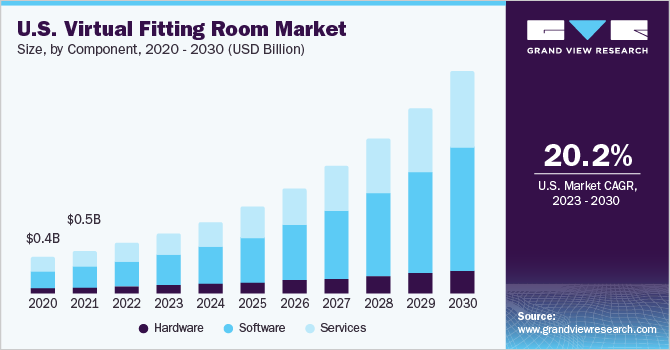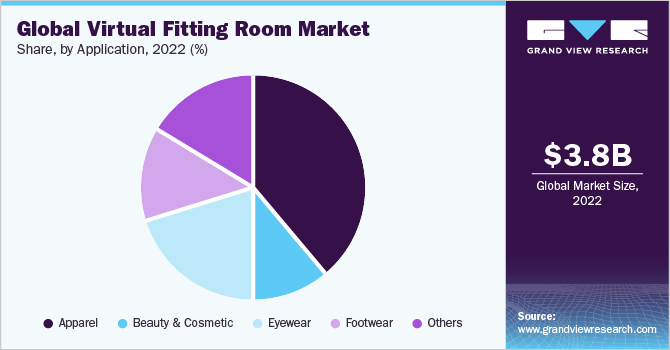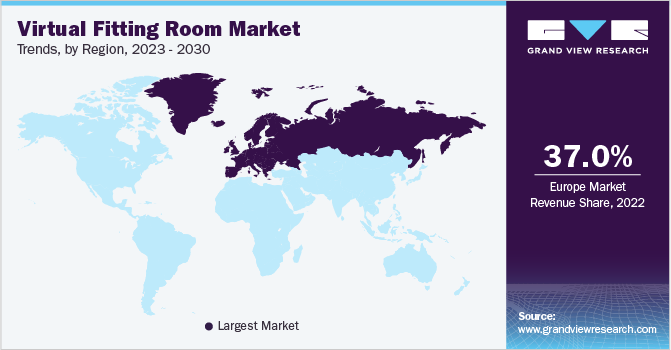- Home
- »
- Next Generation Technologies
- »
-
Virtual Fitting Room Market Trends & Analysis Report, 2030GVR Report cover
![Virtual Fitting Room Market Size, Share & Trends Report]()
Virtual Fitting Room Market Size, Share & Trends Analysis Report By End-use (Physical Store, Virtual Store), By Component (Hardware, Software), By Application (Apparel, Eyewear), By Region, And Segment Forecasts, 2023 - 2030
- Report ID: GVR-4-68039-334-2
- Number of Pages: 150
- Format: Electronic (PDF)
- Historical Range: 2018 - 2021
- Industry: Technology
Virtual Fitting Room Market Size & Trends
The global virtual fitting room market size was valued at USD 3.78 billion in 2022 and is expected to grow at a compound annual growth rate (CAGR) of 24.1% from 2023 to 2030.The emergence of Virtual Reality (VR) and Augmented Reality (AR) technology in virtual fitting room solutions, offering enhanced realism and immersion, is expected to boost market expansion significantly. In addition, numerous companies are rapidly exploring the integration of VR shopping experiences into their physical storefronts and online platforms, as it enhances the user’s purchasing experience, which is expected to boost the market growth further over the forecast period. For instance, in March 2022, Walmart Inc. launched a virtual try-on tool to help their customers experience the clothing items with the help of a virtual model that suits the respective customer’s body type, hair color, and skin tone, which is driving the market growth.

Virtual fitting rooms, which initially took the form of 2D overlays imitating in-store changing room, faced a sluggish reception within the fashion retail sector. However, the market has recently witnessed strong demand due to the emergence of 3D technologies that utilize mannequins to accurately determine user sizes. Virtual 3D fitting rooms serve as collaborative platforms between customers and fashion brands, aiming to enhance customer confidence and reduce return/exchange rates resulting from sizing and fitting issues. The increasing prevalence of intelligent technologies, such as high-definition lenses, smart mirrors, and advanced smartphone cameras, is anticipated to drive the demand for virtual fitting room technology over the forecast period.
Furthermore, the virtual fitting room experiences are becoming more accessible with the help of smartphone applications globally. Consumers can use their smartphones or tablets to try-on clothes virtually, making it more convenient for on-the-go shopping and enhancing the overall experience of consumers. In addition, body scanning technologies are also being utilized in the market to accurately measure customers’ body dimensions and create virtual avatars that closely resemble their physical shelves. This, in turn, is expected to boost the demand for the market over the forecast period. Moreover, the e-commerce retailers have been increasingly incorporating virtual fitting rooms into their online platforms.
The need to reduce returns and enhance customer satisfaction by providing a more accurate representation of the product and its fitting is expected to boost the market demand. In addition, the need to cater to the tailored demands of customers to survive in highly competitive environment is also expected to create numerous growth opportunities for the market over the forecast period. The COVID-19 pandemic has had a profound impact on the overall market. The global industry observed a sharp dip as physical stores across the globe were shut down temporarily as directed by the governments and consumers turned to online shopping.
This led to innovative ways by retailers to provide an immersive shopping experience, which resulted in the integration of VR and AR technology to bridge the gap between physical and virtual fitting rooms. Moreover, the brick-and-mortar retailers are increasingly switching to online services as the web and mobile applications are ideal option as it can be operated with minimum human interaction. As a result, the utilization of virtual fitting room is anticipated to increase for online purchases over the forecast period.
Component Insights
The software segment accounted for the largest share in 2022 and is expected to maintain its lead in the market from 2023 to 2030. The segment is further bifurcated into on-premise and cloud software. Key players focus on targeting their clients through continuous technological advancements and innovations, recognizing software as a fundamental component of virtual fitting room technology. Retailers have witnessed a notable rise in their revenues with the help of progressive and innovative fitting room technology, demonstrating the growing need for personalized “try-before-you-buy” software.This, in turn, is expected to boost the market demand over the forecast period.
The services segment is expected to record the highest CAGR over the forecast period. The segment is further divided into installation, support & maintenance, and consulting. The consulting segment is expected to register the highest CAGR over the forecast period. Market participants emphasize delivering consulting services that ensure the effective operation of their complex offerings. Since the technology is still in the early stages of development, solution providers are offering 24*7 consultation services to assist clients in the effective utilization of the software for their retail businesses, which is expected to augment the market growth during the forecast period.
End-Use Insights
The virtual stores segment recorded a significant revenue share in 2022. Users are inclined towards the ease of e-commerce websites as they offer hassle-free purchases, vast product portfolios, and product comparisons in a few clicks. With the help of virtual fitting room technology, the end-users are effectively assisted in performing improved purchasing decisions, and it has become one of the prominent revenue-generating platforms for online retailers. Moreover, the easiest way to attract customers toward online sales is to cater to their personalized needs and improve the quality of their shopping experiences.
This, in turn, is expected to boost the market demand over the forecast period. The physical stores segment is expected to considerably implement virtual fitting room technology to augment their revenue and sales. The availability of smart mirrors, multi-sensor body scanners, and innovative interactive screens has increased the applications of the technology in physical stores. In addition, numerous attributes, such as the selection of complete outfits based on the customer's desired brands and self-service, are factors complementing the growth of physical stores.
Application Insights
The apparel application segment recorded the largest revenue share in 2022 and is projected to continue the same trend over the forecast period. Moreover, the rising deployment of AR and VR to offer an immersive experience is expected to create growth opportunities for the apparel segment. Apparel sales are among the highest-grossing for both online and physical purchasing modes, and it also includes the highest exchange/return rates. To reduce the return/exchange instances and to enhance the buying experience for customers, online apparel retailers are deploying fitting room solutions with artificial intelligence to recommend the customer sizes, designs, and styles based on their past searches and purchases.

This, in turn, is expected to boost the demand for apparel application segment over the forecast period. The beauty and cosmetic application segment is expected to register the highest growth rate over the forecast period. The rising popularity of e-marketplaces is encouraging famous beauty and cosmetic brands to shift to online product deliveries. Virtual try-on technology, which struggled to attain mainstream adoption, has lately gained traction as it allows consumers to virtually test different looks as well as gather meaningful data on the retail brands, which is expected to fuel the market growth during the forecast period.
Regional Insights
The Europe region accounted for the largest revenue share of over 37% in 2022 and is expected to continue its dominance from 2023 to 2030. This strong growth is attributed to the presence of several notable fashion brands in the region. In addition, the growing demand for improved solutions related to the customer buying experience and rising competitiveness among retailers, as they are increasingly adopting innovative digital technologies to increase footfall as well as engagement levels, are expected to drive the regional market further.

Asia Pacific is anticipated to exhibit a significant CAGR from 2023 to 2030. The rising demand for innovative and progressive solutions that can aid customers in making quick buying decisions is likely to contribute to the regional market growth. The region also holds a considerable market share in the e-commerce sector, with the presence of India, China, Japan, and South Korea outpacing other regions. This, in turn, is expected to propel the growth of the regional market for virtual fitting rooms.
Key Companies & Market Share Insights
The market is classified as highly competitive, with the presence of several players. The key players are focusing on strategic alliances, mergers & acquisitions, expansion, and product development to remain competitive in the industry. For instance, in April 2023, Zalando SE, a leading European online platform for lifestyle and fashion, launched virtual fitting room pilot to cater to millions of customers. With the help of this technology, customers are able to create their 3D avatar by feeding data of their body measurements along with gender and can experience the fitting and size virtually. This, in turn, is anticipated to augment the market growth over the forecast period. Following are some of the major players in the global virtual fitting room market:
-
Autumn Rock Limited (AstraFit)
-
ELSE Corp.
-
FXGear Inc.
-
Metail
-
Fit Analytics
-
Zugara Inc.
-
Sizebay
-
Magic Mirror
-
Fision AG
-
MemoMi Labs Inc.
-
SenseMI
-
triMirror
-
Virtusize Co. Ltd.
-
Visualook
-
Reactive Reality AG
Virtual Fitting Room Market Report Scope
Report Attribute
Details
Market size value in 2023
USD 4.55 billion
Revenue forecast in 2030
USD 20.63 billion
Growth rate
CAGR of 24.1% from 2023 to 2030
Base year for estimation
2022
Historical data
2018 - 2021
Forecast period
2023 - 2030
Report updated
June 2023
Quantitative units
Revenue in USD million/billion and CAGR from 2023 to 2030
Report coverage
Revenue forecast, company ranking, competitive landscape, growth factors, and trends
Segments covered
Component, application, end-use, region
Regional scope
North America; Europe; Asia Pacific; Latin America; Middle East & Africa
Country scope
U.S.; Canada; UK; Germany; France; Spain; Italy; Russia; China; Australia; Japan; South Korea; Brazil; Mexico; UAE; Saudi Arabia
Key companies profiled
Autumn Rock Ltd. (AstraFit); ELSE Corp.; FXGear Inc.; Metail; Fit Analytics; Zugara Inc.; Sizebay; Magic Mirror; Fision AG; MemoMi Labs Inc.; SenseMI; triMirror; Virtusize Co. Ltd.; Visualook; Reactive Reality AG
Customization scope
Free report customization (equivalent to up to 8 analyst working days) with purchase. Addition or alteration to country, regional & segment scope
Pricing and purchase options
Avail customized purchase options to meet your exact research needs. Explore purchase options
Global Virtual Fitting Room Market Segmentation
This report forecasts revenue growth and provides an analysis of the latest trends in each of the sub-segments from 2018 to 2030. For this report, Grand View Research has segmented the global virtual fitting room market based on component, application, end-use, and region:
-
Component Outlook (Revenue, USD Million, 2018 - 2030)
-
Hardware
-
Software
-
On-premise
-
Cloud
-
-
Services
-
Installation
-
Support & Maintenance
-
Consulting
-
-
-
Application Outlook (Revenue, USD Million, 2018 - 2030)
-
Apparel
-
Beauty & Cosmetic
-
Eyewear
-
Footwear
-
Others
-
-
End-use Outlook (Revenue, USD Million, 2018 - 2030)
-
Physical Store
-
Virtual Store
-
-
Regional Outlook (Revenue, USD Million, 2018 - 2030)
-
North America
-
U.S.
-
Canada
-
-
Europe
-
UK
-
Germany
-
France
-
Spain
-
Italy
-
Russia
-
-
Asia Pacific
-
China
-
Australia
-
Japan
-
South Korea
-
-
Latin America
-
Brazil
-
Mexico
-
-
Middle East & Africa (MEA)
-
UAE
-
South Africa
-
-
Frequently Asked Questions About This Report
b. The virtual fitting room market size was valued at USD 3.78 billion in 2022 and is expected to reach USD 4.55 billion in 2023
b. The virtual fitting room market is expected to grow at a compound annual growth rate of 24.1% from 2023 to 2030 to reach USD 20.63 billion by 2030.
b. The apparel segment dominated the virtual fitting room market with a share of over 39% in 2022. This is attributable to the soaring need for solutions that can recommend appropriate apparel based on the customer's preferred sizes, styles, and designs.
b. Some key players operating in the virtual fitting room market include True Fit Corporation, AstraFit, Zugara Inc., and Fit Analytics.
b. Key factors that are driving the virtual fitting room market growth include the rising popularity of the e-commerce sector and the growing concerns of online fashion retailers about delivering products that fit appropriately,
Share this report with your colleague or friend.
![gvr icn]()
NEED A CUSTOM REPORT?
We can customize every report - free of charge - including purchasing stand-alone sections or country-level reports, as well as offer affordable discounts for start-ups & universities. Contact us now
![Certified Icon]()
We are GDPR and CCPA compliant! Your transaction & personal information is safe and secure. For more details, please read our privacy policy.
We are committed towards customer satisfaction, and quality service.
"The quality of research they have done for us has been excellent."





